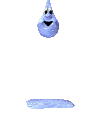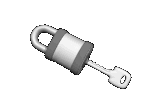Learning Outline
Chemistry of Life
Chemistry Essentials
Chemistry is the basis for all that follows in this course
Basic structural concepts
- Atom – smallest part of a pure substance, or element, that still has the properties of that substance
- Molecule – a particle made up of one or more atoms bound together
- Element – a pure substance, made entirely of one kind of atom (all known elements are listed in the Periodic Table)
- Compound – substance made of molecules that contain more than one kind of atom
Atomic structure and function
“There is nothing worse than a sharp image of a fuzzy concept.” —Ansel Adams
- Nucleus
- Protons have positive (+) charge; number of protons is “atomic number” and signifies kind of atom (which element)
- Neutrons have no charge; optional and variable in number (isotopes)
- Electrons
- Electrons have a negative (-) charge and do not affect the type of element
- Electrons may be present in regions called energy levels
- The further from the nucleus, the more energy is needed by the electron to stay there—so the higher energy levels are farther from the nucleus
- The lowest (first) energy level can contain up to two electrons; the next few can hold up to eight electrons each (the “octet rule“)
- Energy levels fill from the inside out
Behavior of atoms: chemical bonds ![]()
- Atoms want to be “happy” meaning having a full outer energy level
- One path to happiness: ionic bonds
- Occurs when an atom gives one or two electrons to another atom, giving both “full” outer energy levels
- Ion – charged particle (atom or group of atoms)
- Ions “stick” together because opposite charges attract —forming a bond
- Crystal is formed by many ions sticking togther
- Electrolyte – substance that dissolves in water to form ions
- Sometimes the individual, dissolved ions are also called electrolytes
- Another path to happiness: covalent bonds

Other attractions (sometimes also referred to as “bonds” or “weak attractions”)
- Hydrogen bonds (formed when polar molecules stick together)
- Other weak attractions from temporary shifts in charge within molecules
Water
- Water is cohesive—hydrogen bonds make it “sticky”

- May be represented H2O or H-O-H or HOH

- Solvent – something in which other molecules (solutes) are dissolved

- Solution – mixture of solutes dissolved in a fluid solvent
- Water molecules may dissociate into H+ and OH–
- H+ is the hydrogen ion
- OH– is the hydroxide ion
- Solutions with equal proportion of H+ and OH– are “neutral”
- Acids – solutions with higher proportion of H+
- Bases – solutions with a lower proportion of H+ (alkaline solutions)
- Can be expressed as “power of Hydrogen” or pH
- pH scale is an inverse (base 10) logarithm of relative H+ concentration
- 7 = neutral
- acid = anything lower than 7
- base = anything higher than 7
- human blood plasma = pH 7.35-7.45
Buffer – system of molecules that absorb or release H+ —maintaining a relatively stable pH
Water and the chemistry of water will be a continuing theme in this course. A fact that makes a lot of sense when you consider that the body’s internal environment is mostly water.
Biological Molecules
- Macromolecule – giant molecules (many atoms, not just a few)
- Polymer – macromolecule made up of many smaller molecules called “monomers”
- Polymers are assembled by dehydration synthesis
- Polymers are disassembled by hydrolysis
Carbohydrates
- Saccharides (C6H12O6)—sugar groups that make up many carbohydrates
- Monosaccharides—just one saccharide group
- Disaccharides—have two saccharide groups
- Examples: sucrose, maltose, lactose
- Also called “double sugars”
- Polysaccharides—have many saccharide groups
- Example: glycogen (polymer of glucose)
- Examples of function: fuel, fuel storage
Lipids
- Triglycerides – three fatty acid “tails” and one glycerol holding them together
- Nonpolar; hydrophobic
- Fuel
- Phospholipids – two fatty acid “tails” with a “head” containing glycerol and phosphate

- Tails are nonpolar; head is polar
- Form bilayers in water
- Form cellular membranes
- Cholesterol

- Source of steroid lipids (all steroids are derived from cholesterol)
- For example, the steroid hormones are converted from cholesterol
- Stabilizes phospholipid bilayers
- Source of steroid lipids (all steroids are derived from cholesterol)
- Prostaglandins
- 20-carbon fatty acids (unsaturated) with 5-carbon ring
- Regulatory molecules (act as local regulators)
Proteins
- Proteins are folded/twisted chains of amino acids
- Proteins have 50 or more amino acids; polypeptides 10-50, peptides less than 10
- These different categories are used very loosely in real life
- Levels of protein structure (increasing degrees of structural complexity)
- Chaperone molecules assist proteins in folding properly
- The proper (functioning) shape of a protein is called its “native state”
- Denaturation is loss of proper 3D shape (native state)
- May be caused by extreme temp, extreme pH, chemical reactions, other extreme conditions
- Renatured proteins are those that have regained their native state after having been previously denatured
- Chaperone molecules may assist in refolding denatured proteins
- Misfolded proteins must be destroyed (and recycled) or they may cause damage
- May form deadly plaque (gunk)
- Categories of protein shape
- Fibrous proteins
- Globular proteins (globulus “small globe or sphere”)
- Nearly any shape that isn’t “fibrous”
- Also sometimes called globins
- Structure of molecule determines function (it’s all about shape)

- Protein folding has become a vital part of our understanding of how proteins function in the body
- Proteins have 50 or more amino acids; polypeptides 10-50, peptides less than 10
- Structural proteins
- Form structures, e.g. collagen, keratin
- Functional proteins
- Act as “chemists” or “regulators”, e.g. hormones, neurotransmitters, enzymes
- Enzyme action

- Lower “activation energy” of chemical reactions to body temp—that is, make chemistry happen that otherwise wouldn’t happen
- Lock-and-key model
- Enzyme fits substrate as a key fits into a lock
- Enzyme fits substrate as a key fits into a lock
- Active site
- Allosteric site (allosteric “shape changing” effect)

- Cofactors help enzymes
- Organic cofactors are coenzymes, e.g. vitamins
- Enzymes are specific (only work with one type of substrate)
Nucleic acids
- Examples:
- Encode genetic information
- Structure/function of DNA discovered in 1953 by
- James Watson
- Francis Crick
- Maurice Wilkins
- Rosalind Franklin
- Structure/function of DNA discovered in 1953 by
- Nucleotide is the subunit, made of three components
- Sugar (ribose in RNA; deoxyribose in DNA)
- Phosphate
- Nitrogen base
- RNA nucleotides link to form strands that sometimes fold
- Some RNA types do form double strands
- DNA nucleotides form a double strand that twists (double helix)
- Information is encoded in the sequence of nitrogen bases
- Every three bases is one codon or “word” in “genetish”
- Each codon represents one amino acid in a sequence to form a protein
- Genetish is what science author Matt Ridley calls the language of the genetic code
- Every three bases is one codon or “word” in “genetish”
- ATP (adenosine triphosphate) is a modified nucleotide

- Breaking of last phosphate bond can release energy for cell work
- [Very] temporary energy-storage “battery” of cell
- Other modified nucleotides similarly transfer energy
- NAD, FAD, CP
- The role of each of these molecules will be discussed later in the course
Combined forms
- Molecule made up of more than one type of macromolecule
- Examples:
- Glycoprotein
- Proteoglycan
- Glycolipid
- Ribonucleoprotein
- Lipoprotein
See Table 2-4, p.47, of Anatomy & Physiology
7th edition for a summary of major macromolecules.
We’re going to be traveling FAST through this section because you should have had this in your prerequisite course(s). If you need help with this material, let me know.
Readings, References, & Resources
A&P Core
Betts, J. G., DeSaix, P., Johnson, J. E., Korol, O., Kruse, D. H., Poe, B., Wise, J. A., Womble, M., & Young, K. A. (2013). Anatomy and physiology.
Khan Academy. (n.d.). https://www.khanacademy.org/science/health-and-medicine
Patton, K. T. (2013). Survival Guide for Anatomy & Physiology. Elsevier Health Sciences.
Patton, K. T., Bell, F. B., Thompson, T., & Williamson, P. L. (2022). Anatomy & Physiology with Brief Atlas of the Human Body and Quick Guide to the Language of Science and Medicine. Elsevier Health Sciences.
Patton, K. T., Bell, F. B., Thompson, T., & Williamson, P. L. (2023). The Human Body in Health & Disease. Elsevier Health Sciences.
Patton, K. T., Bell, F. B., Thompson, T., & Williamson, P. L. (2024). Structure & Function of the Body. Elsevier Health Sciences.
Topic Focused
Coming soon!
Last updated: February 16, 2025 at 17:19 pm

